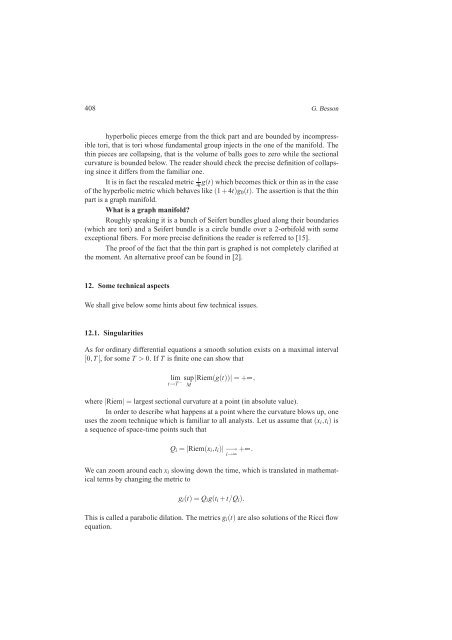G. Besson THE GEOMETRIZATION CONJECTURE AFTER R ...
G. Besson THE GEOMETRIZATION CONJECTURE AFTER R ...
G. Besson THE GEOMETRIZATION CONJECTURE AFTER R ...
Create successful ePaper yourself
Turn your PDF publications into a flip-book with our unique Google optimized e-Paper software.
408 G. <strong>Besson</strong>hyperbolic pieces emerge from the thick part and are bounded by incompressibletori, that is tori whose fundamental group injects in the one of the manifold. Thethin pieces are collapsing, that is the volume of balls goes to zero while the sectionalcurvature is bounded below. The reader should check the precise definition of collapsingsince it differs from the familiar one.It is in fact the rescaled metric4t 1 g(t) which becomes thick or thin as in the caseof the hyperbolic metric which behaves like (1+4t)g 0 (t). The assertion is that the thinpart is a graph manifold.What is a graph manifold?Roughly speaking it is a bunch of Seifert bundles glued along their boundaries(which are tori) and a Seifert bundle is a circle bundle over a 2-orbifold with someexceptional fibers. For more precise definitions the reader is referred to [15].The proof of the fact that the thin part is graphed is not completely clarified atthe moment. An alternative proof can be found in [2].12. Some technical aspectsWe shall give below some hints about few technical issues.12.1. SingularitiesAs for ordinary differential equations a smooth solution exists on a maximal interval[0,T[, for some T > 0. If T is finite one can show thatlim sup |Riem(g(t))| = +∞,t→T −Mwhere |Riem| = largest sectional curvature at a point (in absolute value).In order to describe what happens at a point where the curvature blows up, oneuses the zoom technique which is familiar to all analysts. Let us assume that (x i ,t i ) isa sequence of space-time points such thatQ i = |Riem(x i ,t i )| −→i→∞+∞.We can zoom around each x i slowing down the time, which is translated in mathematicalterms by changing the metric tog i (t) = Q i g(t i + t/Q i ).This is called a parabolic dilation. The metrics g i (t) are also solutions of the Ricci flowequation.














